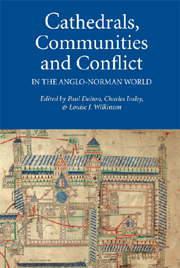Book contents
- Frontmatter
- Contents
- List of Illustrations
- List of Contributors
- Preface
- List of Abbreviations
- Introduction
- 1 The Dangers of Invention: The Sack of Canterbury, 1011, and the ‘theft’ of Dunstan's Relics
- 2 Remembering Communities Past: Exeter Cathedral in the Eleventh Century
- 3 Communities, Conflict and Episcopal Policy in the Diocese of Lichfield, 1050–1150
- 4 The Acta archiepiscoporum Rotomagensium and Urban Ecclesiastical Rivalry in Eleventh-Century Rouen
- 5 Cathedrals and the Cult of Saints in Eleventh-and twelfth-Century Wales
- 6 A Bishop and His Conflicts: Philip of Bayeux (1142–63)
- 7 Ecclesiastical Responses to War in king Stephen's Reign: The Communities of Selby Abbey, Pontefract Priory and York Cathedral
- 8 Secular Cathedrals and the Anglo-Norman Aristocracy
- 9 The Lives of Thomas Becket and the Church of Canterbury
- 10 Caught in the Cross-Fire: Patronage and Institutional Politics in Late twelfth-Century Canterbury
- 11 Crown, Cathedral and Conflict: King John and Canterbury
- 12 The English Monasteries and their French Possessions
- Index of People and Places
- Other Volumes in Studies in the History of Medieval Religion
Introduction
Published online by Cambridge University Press: 12 September 2012
- Frontmatter
- Contents
- List of Illustrations
- List of Contributors
- Preface
- List of Abbreviations
- Introduction
- 1 The Dangers of Invention: The Sack of Canterbury, 1011, and the ‘theft’ of Dunstan's Relics
- 2 Remembering Communities Past: Exeter Cathedral in the Eleventh Century
- 3 Communities, Conflict and Episcopal Policy in the Diocese of Lichfield, 1050–1150
- 4 The Acta archiepiscoporum Rotomagensium and Urban Ecclesiastical Rivalry in Eleventh-Century Rouen
- 5 Cathedrals and the Cult of Saints in Eleventh-and twelfth-Century Wales
- 6 A Bishop and His Conflicts: Philip of Bayeux (1142–63)
- 7 Ecclesiastical Responses to War in king Stephen's Reign: The Communities of Selby Abbey, Pontefract Priory and York Cathedral
- 8 Secular Cathedrals and the Anglo-Norman Aristocracy
- 9 The Lives of Thomas Becket and the Church of Canterbury
- 10 Caught in the Cross-Fire: Patronage and Institutional Politics in Late twelfth-Century Canterbury
- 11 Crown, Cathedral and Conflict: King John and Canterbury
- 12 The English Monasteries and their French Possessions
- Index of People and Places
- Other Volumes in Studies in the History of Medieval Religion
Summary
When the Normans invaded England in 1066 cathedrals and the religious communities based in them were a well-established and prominent feature of the ecclesiastical landscape of the British Isles and Normandy. At that time there were fifteen bishoprics in England and seven in Normandy. The Norman sees of avranches, Bayeux, Coutances, Évreux, Lisieux and Sés were subject to the archbishops of Rouen. Although these bishoprics, ‘with the partial exception of Rouen, had been ruined during the settlement perio d in the early tenth century’, from ‘990 the succession to bishoprics seems to have been continuous, and by the second half of the [eleventh] century all were securely established with new cathedrals in the course of construction and embryonic chapters and diocesan administration evolving everywhere’. In England, where the diocesan structure had survived the viking attacks of the late tenth and early eleventh centuries and the danish conquest of 1016, nearly all of the bishops were suffragans of the archbishops of Canterbury, the only exceptions being the archbishops of york and their suffragans, the bishops of Durham. In Scotland it has been suggested that all except the outmost sees of Caithness and Argyll existed before king David I's reign (1124—53), which means that there were then ten or so bisho prics in the country. None of these held metropolitan authority over the others, which was claimed instead from the 1070s onwards by the archbishops of york and, occasionally, by the archbishops of Canterbury until the papacy placed the Scottish church under its direct control in 1192.
- Type
- Chapter
- Information
- Publisher: Boydell & BrewerPrint publication year: 2011

